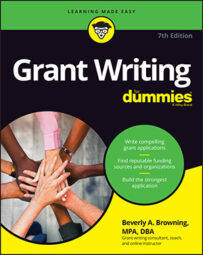If your application guidelines require a separate partnership section, you can and should still have a one- or two-line boilerplate about how many partners your organization has in the organizational capacity narrative section.
In the partnerships section of your organization description narrative, write about your organization’s local, regional, and national collaborative partnerships. What organizations do you team with to provide your program’s services? What organizations have asked you to write letters of commitment for their grant applications? What groups have historically supported you?Partners are like friends: You get to know them inside and out, and you complement each other in the delivery of like or unlike services. For example, say you operate a group home for adults with cognitive and physical disabilities. In that case, you need to depend on the Get ’Em There Transportation Service to take your clients to and from medical appointments.
When writing about your partnerships, list the partner’s full name and its role in relation to your organization. Whether you’re writing a corporate or foundation funding request or a government funding request, the information you provide in your narrative on partnerships is the same: who and where the partner is and what role the partner plays.
As you write about your partnerships, don’t include an organization that you’re considering partnering with without first talking to a representative about what you’re doing and asking permission to include the organization in your proposal. It doesn’t reflect well on you if the funder calls your “partner” and that organization has no clue who you are and no knowledge of a partnership.
When reviewing the partnership section of your funding application, the grant reader looks for evidence of- Collaborative efforts with multiple partners to maximize the use of grant funds by coordinating services to the target population
- Partners that commit cash to reduce the amount of grant funding you need (known as cash contributors)
- Partners that contribute personnel, space, equipment, supplies, and other valuable items to reduce the amount of grant funding needed (known as in-kind contributors)
- Evidence that your partners are committed in writing courtesy of signed Memoranda of Understanding (MOU) and/or letters of commitment
The Northern Arizona Association for the Blind formed the Building Your Vision Partnership in 2013. Current cash contributors include: Sunrise Village Triathlons, Coconino County Center for the Visually Impaired, and Peak Performance. Each of these partners contributed $5,000 towards general operating expenses. Partners that have contributed in-kind (non-cash gifts) include: March for More ($10,000 in technical assistance) and Sight Right ($5,000 in donated assistive technology equipment).
If you prefer, you can present your partner organizations, their partnership roles, and the values of their contributions in a table rather than a paragraph, as shown in Table 13-1. After all, sprinkling graphics and tables throughout your narrative gives the grant reader a break from reading straight text. Remember that grant readers may have to read dozens of grant requests each week. You can give them a much-needed respite from standard sentences and win them over by using a table effectively.
| Partner | Role |
| Arizona State University Cooperative Extension | Life-skills classes for current and former gang members |
| Six Towns Community Center | Training and employment services for current and former gang members |
| Girl Scouts of Coconino County, Inc. | Gender-based programs for female children of current and former gang members |
| Coconino County Housing Authority | Affordable and safe housing, parole violation alert system, as well as family in crisis alert system |
| Coconino County Hispanic Civic Association | Cultural programs to instill a sense of heritage and pride in Hispanic participants |
| City of Flagstaff Police Department | Parole violation alert system; coordination with Project IMPACT, and participant crisis alert system |
| Coconino County Public Schools | Educational and vocational programs for current and former gang members |
| Impact University, Department of Psychology | Interns to mentor and to support project goals for participants |
| Incorporated Village of Kayenta | Technical assistance with linkages |
| Leadership Training Innovations | Grant applicant and lead agency |
| Coconino County Department of Public Health | Health care services and coordinated case management systems for participants with health issues or wishing to have tattoos removed |
| Coconino County Youth Board | Technical assistance throughout project funding period |
| Coconino County Council on the Aging | Volunteers for mentoring current and former gang members |
When you’re writing a short (five pages or less) proposal for corporation or foundation funding sources, don’t create a table to spotlight the grant applicant organization’s partnerships unless you have sufficient room on the second page to accommodate the entire table. Remember, you have four subsections to squeeze into five pages. Revert to using a narrative to describe your partnerships when a table format puts you over the page limit.

